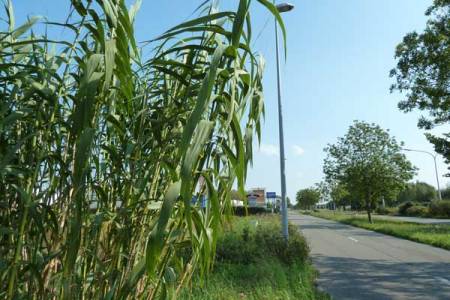1. Arundo donax L. (Asia) – A very rare escape from cultivation or garden throw out but possibly overlooked. Discovered in wasteland in Bornem in 2011: a single young clump grows in the vicinity of a planted specimen (see also: http://waarnemingen.be/waarneming/view/57562390). Also in 2014 discovered by a riverlet (Schijn) in Deurne near Antwerpen and in 2016 by a former railway track in Brussels. In all these localities the species looks well established.
Arundo donax (giant reed) is increasingly planted as an ornamental in gardens in Belgium. Inflorescences are rarely produced and therefore confusion with other rhizomatous, broad-leaved perennial grasses is not unlikely. From Miscanthus it is readily distinguished by its leaves that are regularly arranged on the stem while they are mainly crowded at the base in Miscanthus. Moreover, ligules are membranous in Miscanthus and a line of hairs in Arundo. The latter is particularly reminiscent of native Phragmites. It tends to have thicker rhizomes, thicker and taller culms and wider leaves than the latter but there is some overlap. The existence of a gigantic race of Phragmites australis (subsp. altissimus (Benth.) Clayton; syn.: subsp. pseudodonax (Rabenh.) Rauschert) further adds to the confusion (see for instance Jäger & Werner 2005, Klotz 2005). The main differences between both genera (vegetative as well as generative) are summarised in the couplet below:
- Stems up to 35 mm across and 6 m tall. Leaves with a wedge-shaped brownish area at the base of the leaf blade. Lemma hairy. Glumes subequal. Rachilla glabrous === Arundo
- Stems up to 15 mm across and rarely exceeding 2,5 m. Leaves without a wedge-shaped brownish area at the base of the leaf blade. Lemma glabrous. Glumes unequal (the upper longer). Rachilla sericeous (native) === Phragmites
According to Jäger & al. (2008) a second species of Arundo is also cultivated in Central-Europe, A. plinii Turra, a native of the Mediterranean area. It resembles Arundo donax but is smaller (1-3 m tall) which further complicates the separation from Phragmites australis (Cav.) Trin. ex Steud. in the absence of inflorescences.
Contrary to many authors (see for instance Walters & al. 1984) Arundo donax is not native in the Mediterranean area where it is commonly and widely naturalized since quite a long time.

Literature
Jäger E.J., Ebel F., Hanelt P. & Müller G. (eds.) (2008) Rothmaler Band 5. Exkursionsflora von Deutschland. Krautige Zier- und Nutzpflanzen. Springer Verlag, Berlin: 880 p.
Jäger E.J. & Werner K. (eds.) (2005) Rothmaler Exkursionsflora von Deutschland. Band 4: Gefäßpflanzen: Kritischer Band. Spektrum Akademischer Verlag, München.
Klotz J. (2005) Phragmites australis var. pseudodonax und Spartina pectinata: zwei ungewöhnliche Süßgräser der Regensburger Flora. Hoppea 66: 243-254.
Walters S.M., Brady A., Brickell C.D., Cullen J., Green P.S., Lewis J., Matthews V.A., Webb D.A., Yeo P.F. & Alexander J.C.M. (eds.) (1984) The European Garden Flora, vol. 2 (part II). Cambridge University Press: 318 p.

